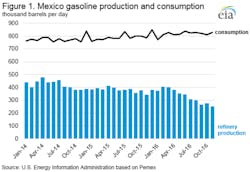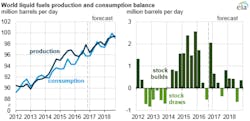Mexican gasoline market reforms could influence US exports
Graphic courtesy of the EIA
Mexico is a large crude oil producer, but it relies heavily on imports of gasoline from the U.S. to meet domestic demand. As a result, the outcome of gasoline market reforms in Mexico could have significant implications for the sale of U.S.-produced gasoline in the U.S., according to the U.S. Energy Information Administration (EIA).
Previous energy sector reforms in Mexico ended the state-owned company Petróleos Mexicanos upstream monopoly, opening the oil and natural gas sectors to foreign direct investment. Last year, the country began allowing other entities to import gasoline and diesel and open retail stations, which could have an impact on U.S. gasoline export trends.
Natural gas prices expected to increase
The Henry Hub natural gas spot price is expected to average $3.55 per million British thermal units (MMBtu) in 2017 and $3.73/MMBtu in 2018, according to the EIA January 2017 Short-Term Energy Outlook. Both predictions are higher than the 2016 average of $2.51/MMBtu. The higher prices in 2017 and 2018 reflect natural gas consumption and exports exceeding supply and imports, which leads to lower average inventory levels.
US LNG exports reach record levels
U.S. exports of liquefied natural gas (LNG) from Sabine Pass LNG terminal in December 2016 exceeded the record set the previous month, with 12 exported cargoes totaling an estimated 42.8 billion cubic feet (Bcf) of natural gas, according to the EIA.
Eight of the 12 exports were shipped to Asia to satisfy residential heating demand due to cold winter temperatures. Rising spot LNG prices also prompted larger price spreads between the Atlantic and Pacific basins, adding greater incentive for U.S. exports.
Sabine Pass is the first LNG export facility in the Lower-48 states. December’s exports were at or near the maximum capacity that can be produced there.
Graphic courtesy of the EIA
Global crude oil balances expected to tighten through 2018
Crude oil and other liquid inventories grew by 2.0 million barrels per day (b/d) in the fourth quarter of 2016, fueled by an increase in production and a large but seasonal reduction in consumption, according to EIA estimates. Global production and consumption are projected to increase through 2018, but consumption is expected to outpace production. As a result, global balances are expected to tighten.
Strategic Petroleum Reserve sales to start this month
The U.S. Department of Energy’s (DOE) Office of Fossil Energy awarded contracts for the first of several sales of crude oil from the Strategic Petroleum Reserve (SPR), the largest government-owned emergency crude oil in the world. The SPR was established to help ease major oil supply reductions from various geopolitical events including severe weather or unplanned production curtailments.
A Continuing Resolution, which began in December 2016, includes a provision for the DOE to sell up to $375.4 million in crude oil from the SPR. This sale will be the first of several totaling nearly 190 million barrels during fiscal years 2017 through 2025, the EIA announced.
Federal revenues from energy on federal lands decline
The U.S. government received nearly $6 billion in revenues from royalties, rental costs and other fees from activities related to energy production on federal and Native American lands during the 2016 fiscal year, according to the Department of Interior’s Office of Natural Resource Revenue. Activities include the production of coal, oil, natural gas, hydrocarbon gas liquids (HGLs) and renewables. Revenues for the fiscal year 2016 were the lowest since 2004.
HGL a key factor in overall liquid fuel balance changes
HGLs, in particular ethane, is becoming a significant factor in global liquid fuels balances, according to the EIA’s Short Term Energy Outlook (STEO) for January. HGL is a group of products that includes ethane, propane, normal butane, isobutane, natural gasoline and refinery olefins.
Changes in HGL accounted for most of the forecast increases to U.S. liquids supply and consumption in 2017 and 2018. More than 13 percent of the forecast growth in total world consumption can be attributed to the U.S. HGL demand growth.
LNG floating storage to build momentum through 2017
According to market research and intelligence company Genscape, floating LNG storage will strengthen in 2017, driven by building momentum of U.S. and Australian liquefaction trains.
Most of U.S. Australian production will come online in 2018, providing a more complete story of the floating storage market. Global supply and demand can be better understood with improved tracking of floating offshore storage and total LNG volume at sea as the global supply increases by 40 percent.
US ethane production expected to grow
Ethane production in the U.S. is expected to increase from an average of 1.25 million barrels per day (b/d) in 2016 to 1.7 million b/d in 2018, according to the EIA. The petrochemical industry is expected to consume the increase in ethane production domestically and abroad.




